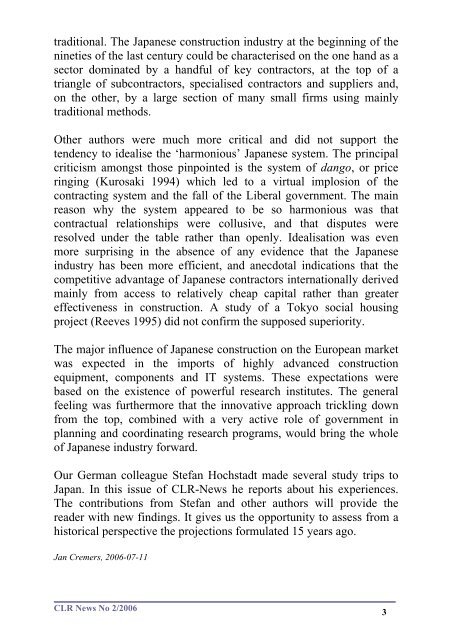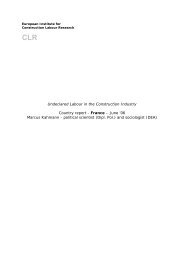Japan – what can we learn? - Construction Labour Research
Japan – what can we learn? - Construction Labour Research
Japan – what can we learn? - Construction Labour Research
You also want an ePaper? Increase the reach of your titles
YUMPU automatically turns print PDFs into web optimized ePapers that Google loves.
traditional. The <strong>Japan</strong>ese construction industry at the beginning of thenineties of the last century could be characterised on the one hand as asector dominated by a handful of key contractors, at the top of atriangle of subcontractors, specialised contractors and suppliers and,on the other, by a large section of many small firms using mainlytraditional methods.Other authors <strong>we</strong>re much more critical and did not support thetendency to idealise the ‘harmonious’ <strong>Japan</strong>ese system. The principalcriticism amongst those pinpointed is the system of dango, or priceringing (Kurosaki 1994) which led to a virtual implosion of thecontracting system and the fall of the Liberal government. The mainreason why the system appeared to be so harmonious was thatcontractual relationships <strong>we</strong>re collusive, and that disputes <strong>we</strong>reresolved under the table rather than openly. Idealisation was evenmore surprising in the absence of any evidence that the <strong>Japan</strong>eseindustry has been more efficient, and anecdotal indications that thecompetitive advantage of <strong>Japan</strong>ese contractors internationally derivedmainly from access to relatively cheap capital rather than greatereffectiveness in construction. A study of a Tokyo social housingproject (Reeves 1995) did not confirm the supposed superiority.The major influence of <strong>Japan</strong>ese construction on the European marketwas expected in the imports of highly advanced constructionequipment, components and IT systems. These expectations <strong>we</strong>rebased on the existence of po<strong>we</strong>rful research institutes. The generalfeeling was furthermore that the innovative approach trickling downfrom the top, combined with a very active role of government inplanning and coordinating research programs, would bring the wholeof <strong>Japan</strong>ese industry forward.Our German colleague Stefan Hochstadt made several study trips to<strong>Japan</strong>. In this issue of CLR-News he reports about his experiences.The contributions from Stefan and other authors will provide thereader with new findings. It gives us the opportunity to assess from ahistorical perspective the projections formulated 15 years ago.Jan Cremers, 2006-07-11CLR News No 2/20063









